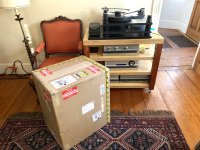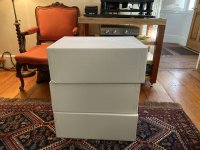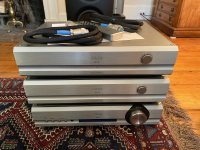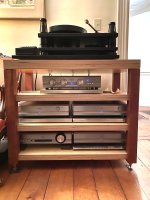Pass Labs XP-32 Listening Impressions
Part 1
System Background and Goals:
I have owned many Pass Labs preamps. I bought my first in the late 1990s and have made steady upgrades ever since: Aleph P, X-1, X-20, XP-22, XP-32. I have always found these products good sounding, extremely well built, and very reliable. The rest of the system is as follows: van den Hull cartridge, SME V-12 and SME 3012R tone arms, SME 30/12 turntable, Pass XP-27 phono, Pass XP-32 preamp, Pass XA160.5 amps, Magico Q3 speakers, DIY cables.
I have owned and enjoyed the XP-22 for about two years. It is the generation after Wayne Colburn designed his flagship XS Preamp and is supposed to benefit from some trickle down improvements over the XP-20, namely a much better umbilical cord, the volume control from the XP-30, and lower noise. The improvement over the XP-20 was worthwhile, but it was more incremental than anything major.
Over the past few years, I have spent more time listening to live acoustic music. I spent five days listening to closed rehearsals at the Vienna State Opera followed by different evening performances from the Director’s box. My mentor and host wanted me to learn more about the sound of real thing and by more closely focusing on the energy of the sound leaving the both singers up on stage and the instruments down in the orchestra pit. I also attended quite a few BSO performances from the seventh row center and some small chamber recitals in a living room setting in Boston. Much of this listening was from a close vantage point where the sound was immediate and direct.
With the memories of these live music experiences in my mind, I began to make some major, some might say radical changes to my audio system in an attempt to better capture that sense of incredible energy, clarity, and natural sound of live music. My system was somewhat artificial and not that natural sounding. It was a bit too “hifi”. It lacked the sense of “life” and energy that I heard live. I did not fully understand what was lacking until I started to experiment and make some changes.
I removed all pneumatic isolation platforms from under each component and replaced them with 14” X 18” X 1” 75 lb. stainless steel plates supported by large rubber O rings. I removed all acoustic treatments from the room, with the exception of one small absorption panel on the back wall 14” behind the listening seat. Upholstered chairs replaced absorption panels at the first reflection points. I played around with the location of the rug. Four 16” tube traps were removed from the front wall corners. I replaced expensive audiophile signal cables and power cords with DIY cables and Ching Cheng cords. Finally, I repositioned my speakers and slowly reduced toe-in to zero, or facing straight ahead.
I wanted to simplify my system, but I was also trying to achieve a more “natural” sound, one with more energy and life. The system is located in my formal living room. For years I sacrificed aesthetics for audiophile accessories and what I thought was my preferred sound. The more I listened to live music, the more I realized it was time for a change. These changes resulted in a less artificial, less focused, less “hifi” sound. Space opened up, timbre and dynamics improved. The sound became more alive and more natural. I was satisfied that I was moving in the right direction.
I made two equipment purchases during this time. I designed and had machined an outboard arm pod for a new SME 3012R tonearm, and I bought a van den Hul Colibri Master Signature cartridge. I mention all of this as background to explain that I think the sound of my system has changed pretty dramatically over the last year or so, but also to suggest that the system sounds less restricting and I think it is very likely that the differences between the XP-22 and XP-32 are more clearly audible than they might otherwise have been without these changes to my system. It is also an attempt to describe the type of sound I am trying to achieve.








